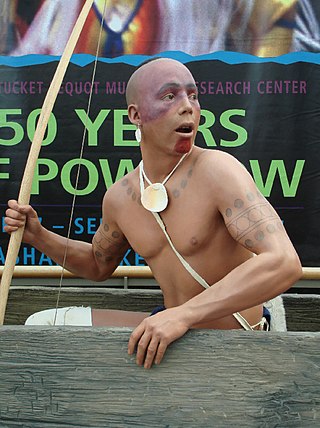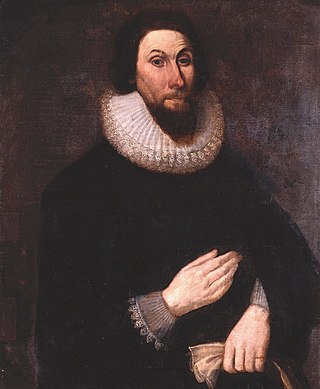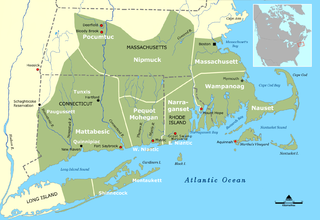
Roger Williams was an English-born New England Puritan minister, theologian, and author who founded Providence Plantations, which became the Colony of Rhode Island and Providence Plantations and later the State of Rhode Island. He was a staunch advocate for religious freedom, separation of church and state, and fair dealings with the Native Americans.

The Pequot are a Native American people of Connecticut. The modern Pequot are members of the federally recognized Mashantucket Pequot Tribe, four other state-recognized groups in Connecticut including the Eastern Pequot Tribal Nation, or the Brothertown Indians of Wisconsin. They historically spoke Pequot, a dialect of the Mohegan-Pequot language, which became extinct by the early 20th century. Some tribal members are undertaking revival efforts.

The Mashantucket Pequot Tribal Nation is a federally recognized American Indian tribe in the state of Connecticut. They are descended from the Pequot people, an Algonquian-language tribe that dominated the southern New England coastal areas, and they own and operate Foxwoods Resort Casino within their reservation in Ledyard, Connecticut. As of 2018, Foxwoods Resort Casino is one of the largest casinos in the world in terms of square footage, casino floor size, and number of slot machines, and it was one of the most economically successful in the United States until 2007, but it became deeply in debt by 2012 due to its expansion and changing conditions.

John Winthrop was an English Puritan lawyer and a leading figure in the founding of the Massachusetts Bay Colony, the second major settlement in New England following Plymouth Colony. Winthrop led the first large wave of colonists from England in 1630 and served as governor for 12 of the colony's first 20 years. His writings and vision of the colony as a Puritan "city upon a hill" dominated New England colonial development, influencing the governments and religions of neighboring colonies in addition to those of Massachusetts.

The Pequot War was an armed conflict that took place in 1636 and ended in 1638 in New England, between the Pequot tribe and an alliance of the colonists from the Massachusetts Bay, Plymouth, and Saybrook colonies and their allies from the Narragansett and Mohegan tribes. The war concluded with the decisive defeat of the Pequot. At the end, about 700 Pequots had been killed or taken into captivity. Hundreds of prisoners were sold into slavery to colonists in Bermuda or the West Indies; other survivors were dispersed as captives to the victorious tribes.

The Connecticut Colony, originally known as the Connecticut River Colony, was an English colony in New England which later became the state of Connecticut. It was organized on March 3, 1636 as a settlement for a Puritan congregation of settlers from the Massachusetts Bay Colony led by Thomas Hooker. The English would secure their control of the region in the Pequot War. Over the course of the colony's history it would absorb the neighboring New Haven and Saybrook colonies. The colony was part of the briefly-lived Dominion of New England. The colony's founding document, the Fundamental Orders of Connecticut has been called the first written constitution of a democratic government, earning Connecticut the nickname "The Constitution State."

The Niantic are a tribe of Algonquian-speaking American Indians who lived in the area of Connecticut and Rhode Island during the early colonial period. The tribe's name Nehântick means "of long-necked waters"; area residents believe that this refers to the "long neck" or peninsula of land known as Black Point, located in the village of Niantic, Connecticut.
Edmund Sears Morgan was an American historian and an authority on early American history. He was the Sterling Professor of History at Yale University, where he taught from 1955 to 1986. He specialized in American colonial history, with some attention to English history. Thomas S. Kidd says he was noted for his incisive writing style, "simply one of the best academic prose stylists America has ever produced." He covered many topics, including Puritanism, political ideas, the American Revolution, slavery, historiography, family life, and numerous notables such as Benjamin Franklin.

John Mason was an English-born settler, soldier, commander and Deputy Governor of the Connecticut Colony. Mason was best known for leading a group of Puritan settlers and Indian allies on a combined attack on a Pequot Fort in an event known as the Mystic Massacre. The destruction and loss of life he oversaw effectively ended the hegemony of the Pequot tribe in southeast Connecticut.

The Saybrook Colony was a short-lived English colony established in New England in 1635 at the mouth of the Connecticut River in what is today Old Saybrook, Connecticut. Saybrook was founded by a group of Puritan noblemen as a potential political refuge from the personal rule of Charles I. They claimed possession of the land via a deed of conveyance from Robert Rich, 2nd Earl of Warwick, which granted the colony the land from the Narragansett Bay to the Pacific Ocean. Saybrook was named in honor of two of its primary investors, the Lords Saye and Sele and Brooke. John Winthrop the Younger was contracted as the colony's first governor, but quickly left Saybrook after failing to enforce its authority over Connecticut's settlers. With Winthrop gone, Lion Gardiner was left in charge of Saybrook's considerable fort, defending it when it was besieged during the Pequot War. Governor George Fenwick arrived in the colony in 1639, but quickly saw it as a lost cause. Fenwick negotiated the colony's sale to Connecticut in 1644 after interest in colonization dried up due to the investors' involvement in the English Civil War.

The Mystic massacre – also known as the Pequot massacre and the Battle of Mystic Fort – took place on May 26, 1637 during the Pequot War, when a force from the Connecticut Colony under Captain John Mason and their Narragansett and Mohegan allies set fire to the Pequot Fort near the Mystic River. They shot anyone who tried to escape the wooden palisade fortress and killed most of the village. There were between 400 and 700 Pequots killed during the attack; the only Pequot survivors were warriors who were away in a raiding party with their sachem Sassacus.
Robert Seeley, also Seely, Seelye, or Ciely, (1602–1668) was an early Puritan settler in the Massachusetts Bay Colony who helped establish Watertown, Wethersfield, and New Haven. He also served as second-in-command to John Mason in the Pequot War.
The War of 1812 bibliography is a selective, annotated bibliography using APA style citations of the many books related to the War of 1812. There are thousands of books and articles written about this topic. Only the most useful are presented.
Canonchet was a Narragansett Sachem and leader of Native American troops during the Great Swamp Fight and King Philip's War. He was a son of Miantonomo.

The New England Colonies of British America included Connecticut Colony, the Colony of Rhode Island and Providence Plantations, Massachusetts Bay Colony, Plymouth Colony, and the Province of New Hampshire, as well as a few smaller short-lived colonies. The New England colonies were part of the Thirteen Colonies and eventually became five of the six states in New England, with Plymouth Colony absorbed into Massachusetts and Maine separating from it.
Events from the year 1798 in the United States.

The Pequot Fort was a fortified Native American village in what is now the Groton side of Mystic, Connecticut, United States. Located atop a ridge overlooking the Mystic River, it was a palisaded settlement of the Pequot tribe until its destruction by Puritan and Mohegan forces in the 1637 Mystic massacre during the Pequot War. The exact location of its archaeological remains is not certain, but it is commemorated by a small memorial at Pequot Avenue and Clift Street. The site previously included a statue of Major John Mason, who led the forces that destroyed the fort; it was removed in 1995 after protests by Pequot tribal members. The archaeological site was added to the National Register of Historic Places in 1990.
Wequash Cooke was allegedly one of the earliest Native American converts to Protestant Christianity, and as a sagamore he played an important role in the 1637 Pequot War in New England.
Alfred A. Cave was an American professor, historian, and author. He was a Professor Emeritus of History at the University of Toledo, specializing in the ethnohistory of Colonial America, Native Americans, and the Jacksonian era.

Alfred Fabian "Al" Young (1925–2012) was an American historian. Young is regarded as a pioneer in the writing of the social history of the American Revolution and was a founding editor of the academic journal Labor: Studies in Working-Class History of the Americas.












